
 |
|||||
|
|
|||||
|
|
|
|||||
|
|
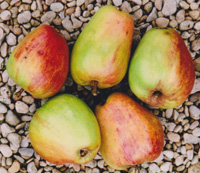 |
LAMPORT SHEEP’S NOSE Stowe is now a Country Park in Buckinghamshire, landscaped by Capability Brown for Earl Temple in the first part of the 18th century, but it once contained four villages. Three of these were enclosed, abandoned and removed to become parkland. One of these was Lamport – a village noted in Domesday and gone by 1739. After all buildings were removed, the orchard at the rectory was left alone. In conversations with Michael Harrison, Estate Manager at Wotton Estate, he told us of an apple known at Stowe as ‘Sheep’s Nose’, but which was different from The Buckinghamshire Sheep’s Nose, we knew. Michael gave us a small tree of it a couple of years later. The original tree is obviously very old. It turns out that it was the same as a tree we have here, grafted twenty years before, from a cutting from Stowe. We did not have a name for it. When we had dna tests done on both, they were clearly the same. The medium sized apple is rather odd and variable in shape, but mostly long and tapering, some very long, with an asymmetric habit that makes it very much the shape of a sheep’s nose. It is ripe in mid-September, with a base colour of pale green and with brightly coloured red streaks and flecks. The flesh is fairly crisp and juicy, of moderate sweetness and sometimes with a little tannin, but often without. The flavour is rather curious, perhaps a little musty or floral, but perfectly pleasant. The apples will last into November. Pollination Group 3 |
||
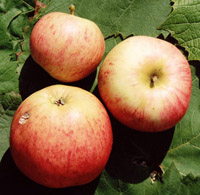 |
LANCASHIRE PIPPIN There are two distinct sorts of Lancashire Pippin recorded in the National Apple Register of 1971; Lancashire Pippin 1 is ‘missing’ (recorded and last heard of in 1883, having been exhibited from Westmorland). It is middle-season, small and tall in shape. Lancashire Pippin 2 has been in the National Collection since 1950. It is the latter that we offer here. Lancashire Pippin 2 is a culinary, late apple, of medium size, ripe in Oct-Nov. The skin is greenish yellow, with an orange flush and pale to dark carmine-red stripes in the sun. Sometimes it can become quite dark. The flesh is initially firm, creamy-white and sharp, but mellows after storage. When cooked it goes soft quite quickly, keeps some shape but will go to a purée if wanted. By mid November it will go directly to a fluff. It can be a little sharp but, when sugar is added, it brings out a very rich flavour. In some years it can be a pleasant eating apple. Very striking deep pink and white blossom. Free spurring. T. Pollination Group 6 |
|||
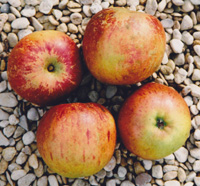 |
LANCASHIRE
PIPPIN (GROVE) Around 25 years ago, we obtained scions of several
varieties from the Grove Heritage Collection in Tasmania, Australia, which
listed several names of British apples and pears that were no longer known
anywhere else in the world. This apple was simply called Lancashire Pippin,
but when it fruited it was found to be different from that of the same
name in the National Collection here, an apple which we had before the
Tasmanian import. Two seemingly different Lancashire Pippins have been
noted in the past and it seems that the only match with the Tasmanian
apple could be with an apple last known in 1883, when it was exhibited
by Mr Charles Crossland, the Gardener at Beachwood, Arnside, Westmorland,
at the National Apple Congress. He reported that “the apples I have
sent may not be as fine as might be anticipated, but as they are gathered
from such old trees, much finer could not be expected”. The Congress
observed that the examples were all small, very deficient in colouring,
being green and unripe looking, and all more or less acid. Mr Crossland
noted (in 1883) that all the apples he exhibited had been grown on the
Beachwood Estate for over 200 years, presumably from records kept by Mr
Saul, a former owner of Beachwood. That would put the age of this apple
at pre-1683. The apple we describe here is medium sized, sometimes large,
and is not deficient in colouring, having quite a broad carmine flush.
Mr Crossland did say that his exhibited apples were not the best, and
presumably not the most typical. The apple we know is light green to pale
yellow, with carmine flecks and a broad flush, rounded in shape, but sometimes
a little flat. It is quite a variable apple, sometimes with pronounced
russet around the stalk and sometimes with an orange base, mottled with
scarlet. It is ripe from October to November and while in some years it
can become sweet enough to eat with pleasure, it is usually a shade too
acidic. When cooked, it keeps all its shape but would mash. The flavour
is rich, sweet, fruity and tangy. Some would want to add just a little
sugar, while others would find no need. The apples will keep to the year
end or beyond, with care. Pollination Group 3 |
|||
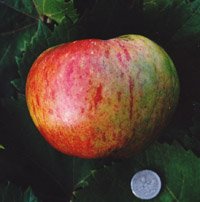 |
LANE’S
PRINCE ALBERT
A cooking apple, which originated in Berkhamsted in the garden of quaker
Thomas Squire. He transplanted the tree to his front garden on the day
that Queen Victoria and Prince Albert called in the town, to change horses
at the King's Arms. He named it Victoria and Albert. John Lane, a grower
in the town, was impressed by the tree because of its compact nature and
heavy crops, and he introduced it as Lane’s Prince Albert in 1857.
The original tree remained until 1958, when the house and garden were
removed to make way for new building. The fruit is large and slightly
shiny, with a green skin, warmly blushed and flecked red, and with white,
juicy flesh. When cooked it keeps its shape, but softens completely, with
a fine blend of sugar and acid. Sometimes the addition of a little sugar
brings out the rich tangy flavour. By March it becomes sweet enough to
eat. Hogg called it a marvellous bearer and Bunyard a very reliable cropper,
and all that is true. Pollination Group 4 |
|||
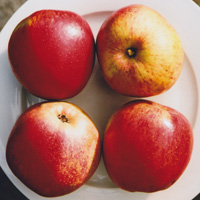 |
LANGLEIGH
DELIGHT An old variety, probably Devonish, sent to us by Jeremy
Sansom of Watermouth in Devon. The old, tall, upright growing tree is
now an orphaned remnant of an old orchard, formerly part of the old Langleigh
Estate, near Ilfracombe. It stands now by the side of the road that was
formerly the main access to the old estate. Jeremy reported that the tree
stays laden with apples in December, but we have not found that here.
It is a characteristic of some trees in some years, but seemingly dependent
on the summer’s weather. The red apples are large, heavy and with
dense, juicy, crisp, sweet flesh. A good cooking apple, but in warm summers
it is also a sweet and rich dessert apple when ripe in October. The apple
is about 4 inches wide and tall, tapered/conical with a hint of ribbing,
more so at the eye, and widely blushed with bright red. It has a rich
flavour, keeping its shape when cooked, without the need for sugar. The
original name is unknown and it does not appear to be any variety still
known, hence Mr Sansom’s new name of Langleigh Delight. We thank
Mr Sansom for his efforts in keeping this interesting old variety going
and for sending us fruit and scions. Pollination Group 5 |
|||
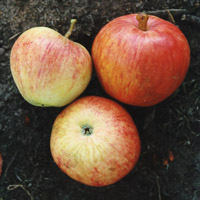 |
LANGLEY
PIPPIN An early season apple of the late nineteenth century from
Veitch’s Nursery of London, who also had a fruit tree nursery near
Langley in Buckinghamshire, where this was raised. They crossed Cox’s
Orange Pippin with Gladstone. Very attractive, slightly conical apples,
with a deep crimson flush and juicy, aromatic, sweet, crisp flesh in late
August. The apples will not be so good by November. The trees have a spreading
habit. Pollination Group 5 |
|||
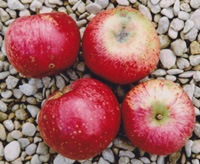 |
LANGTON’S
NONSUCH This was originally called Langton None Such when described
by the Reverend William Hanbury of Church-Langton, Leicestershire, in
‘A Complete Body of Planting and Gardening’ in 1770. It was
also noted by Richard Weston in “The Gardener’s and Planter’s
Calendar” in 1773, being in use in September. Hanbury said it “is
a large, beautiful Apple, finely stained, or variegated with red and yellow
next the sun, and of a greenish-yellow colour on the opposite side. The
flesh is tender, and full of juice, which, in dry, warm situations, is
so rich as the render the fruit equal to an orange in goodness. In cold,
deep, and rich soils the fruit becomes very large, the juice copious,
and the sour overcomes the sweet in such great disproportion as to edge
the teeth and gain disrepute to the fruit: So that whoever is fond of
this Apple for the table must allow the tree a dry, warm soil, and the
fruit will be excellent about the end of September. This apple is also
the best for Kitchen purposes of any I know; and the tree being very hardy,
and a great bearer, is, perhaps, as well worth propagating as any Apple
in the known world; tho’ the fruit does not continue long good;
it becoming mealy in November, and rarely lasting longer than Christmas.”
In the old literature since, it was made a synonym of Nonsuch and fell
victim to the careless habit of similar apples being merged. Throughout
old works we see the same habit of making apples synonymous by authors
who merely copy others and behave like circus elephants, trunk to tail
in a circle. Langton’s Nonsuch disappeared. Some years back, Nigel
Deacon and Melanie Wilson, founders of the Leicestershire Heritage Apple
Project, were determined to rediscover this apple and tracked it down
to a German owner, bringing it back to Leicestershire. They sent us scions
several years ago, now, and we are all agreed that it fits Hanbury’s
description perfectly (as does another they found locally – but
that is a different story). More recently we found Langton Sondergleichen
listed at the Julius Kuhn Institute collection in Germany and received
scions here. Sondergleichen means literally ‘without compare’
or ‘none such’. We have dna profiled both apples and they
are the same. Incidentally, we have dna profiled the Nonsuch we received
back from America – a very similar apple to Langton’s Nonsuch
– but different from Langton’s Nonsuch. The case against the
historic error of making them synonymous rests! Nigel Deacon, who routinely
tests apples for their vitamin C content finds this apple to have the
highest content by some distance. This apple is uniformly round and very
brightly streaked with crimson, stained a little pink under the skin,
medium sized, sometimes larger, and is ripe in mid September. It is crisp
and juicy with some sweetness but too lemony and sharp to enjoy raw. When
cooked, it breaks up, is very rich, still lemony and a little sharp, but
with added sugar it is very good indeed. Pollination Group 4 |
|||
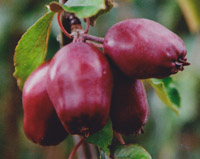 |
LARGE SIBERIAN RED-FLESHED CRAB One of several ancient Siberian Crabs that have been utilized in cider making or as breeding stock for other cider varieties. A very showy, fruit that hangs in clusters and is ripe in late September, though it is always sharp and hard to judge its correct time of ripeness. The long, ribbed, apples are not as large as the name suggests, being more medium sized, but larger than the fruit of other Siberian Crabs. They are deep carmine to maroon in the sun and pale carmine in the shade. The flesh is stained red throughout. In November the interior has begun to decay. Use in October for cider. Pollination Group 4 |
|||
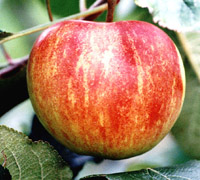 |
LAXTON'S
EPICURE It is also commonly known as ‘Epicure’. A
mid season dessert apple raised by the Laxton Brothers of Bedford, in
1909 as a cross between Cox's Orange Pippin and Wealthy. Sweet, juicy
and crisp apples, with a rich flavour, redolent of Cox but adding something
more. The skin is flushed and streaked with bright red. A popular garden
variety, which produces heavy crops, ready in September. The apples will
keep for a month or so, and become softer and richer with storage. The
blossom is large and attractive. Pollination Group 4 |
|||
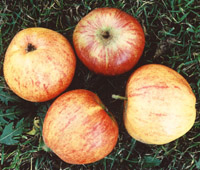 |
LAXTON’S EXQUISITE Raised in 1902 by Laxton Bros. of Bedford, a cross of Cox Orange Pippin x Cellini. It was exhibited by Laxtons in 1926 and received an Award of Merit. It entered the National Fruit Trials in 1928. Similar in nature to Cox, but larger, taller, and slightly angular. The golden skin is streaked with red, the flesh is white and crisp with a rich flavour. Ripe in September and keeping to October. It is also known as Exquisite, but this name is incorrect, since an earlier Exquisite existed, being recorded by Scott in 1872. Pollination Group 3 | |||
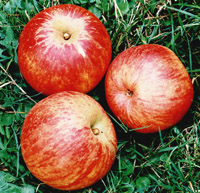 |
LAXTON'S FORTUNE Also commonly known as Fortune. Another Bedfordshire apple, raised in 1904, but not introduced until 1931. A sweet, juicy apple with Cox as one parent, thereby inheriting some of its characteristic flavour. Easier to grow than Cox, the trees are vigorous and hardy and produce heavy crops. Ready in September, it stores for a month or two. Pollination Group 3 |
|||
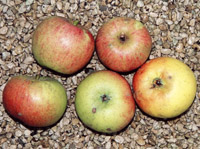 |
LAXTON’S
ROYALTY A late dessert apple and a cross between Cox’s
Orange Pippin and Court Pendu Plat, with the expected rich flavour. It
has medium sized fruit, which is crisp and juicy, and slightly sharper
than a Cox, for those that like a sharp apple, though it becomes sweeter
with storage. It does not have heavy crops. Sometimes the apple is completely
red. Late flowering, ripe in October and storing until February. Pollination
Group 7 |
|||
|
||||